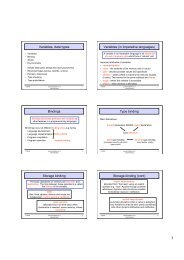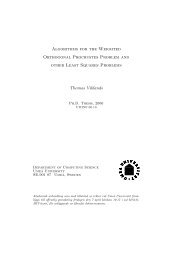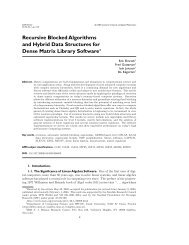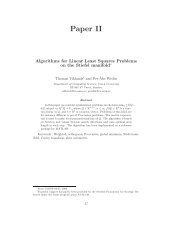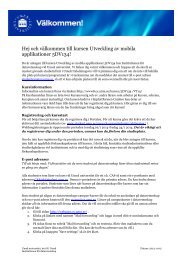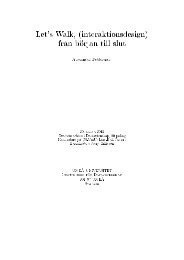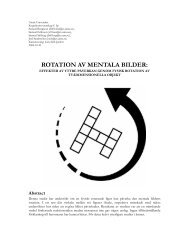Object Tracking and Face Recognition in Video Streams
Object Tracking and Face Recognition in Video Streams
Object Tracking and Face Recognition in Video Streams
- No tags were found...
You also want an ePaper? Increase the reach of your titles
YUMPU automatically turns print PDFs into web optimized ePapers that Google loves.
AbstractThe goal with this project was to improve an exist<strong>in</strong>g face recognition system for videostreams by us<strong>in</strong>g adaptive object track<strong>in</strong>g to track faces between frames. The knowledge ofwhat faces occur <strong>and</strong> do not occur <strong>in</strong> subsequent frames was used to filter false faces <strong>and</strong> tobetter identify real ones.The recognition ability was tested by measur<strong>in</strong>g how many faces were found <strong>and</strong> howmany of them were correctly identified <strong>in</strong> two short video files. The tests also looked at thenumber of false face detections. The results were compared to a reference implementationthat did not use object track<strong>in</strong>g.Two identification modes were tested: the default <strong>and</strong> strict modes. In the default mode,whichever person is most similar to a given image patch is accepted as the answer. In strictmode, the similarity also has to be above a certa<strong>in</strong> threshold.The first video file had a fairly high image quality. It had only frontal faces, one at atime. The second video file had a slightly lower image quality. It had up to two faces at atime, <strong>in</strong> a larger variety of angles. The second video was therefore a more difficult case.The results show that the number of detected faces <strong>in</strong>creased by 6-21% <strong>in</strong> the two videofiles, for both identification modes, compared to the reference implementation.In the meantime, the number of false detections rema<strong>in</strong>ed low. In the first video file,there were fewer than 0.009 false detections per frame. In the second video file, there werefewer than 0.08 false detections per frame.The number of faces that were correctly identified <strong>in</strong>creased by 8-22% <strong>in</strong> the two videofiles <strong>in</strong> default mode. In the first video file, there was also a large improvement <strong>in</strong> strictmode, as it went from recognis<strong>in</strong>g 13% to 85% of all faces. In the second video file, however,neither implementation managed to identify anyone <strong>in</strong> strict mode.The conclusion is that object track<strong>in</strong>g is a good tool for improv<strong>in</strong>g the accuracy offace recognition <strong>in</strong> video streams. Anyone implement<strong>in</strong>g face recognition for video streamsshould consider us<strong>in</strong>g object track<strong>in</strong>g as a central component.


